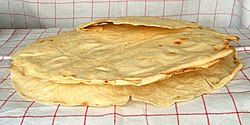food.wikisort.org - Dish
Pane carasau (Sardinian: [ˈpanɛ ɣaɾaˈzau], Italian: [ˈpaːne karaˈzau]; "toasted bread" in Sardinian language, from the past participle of the Sardinian verb carasare "to toast", referring to the crust) is a traditional flatbread from Sardinia. It is called carta da musica in Italian, meaning "sheet music", in reference to its large and paper-thin shape, which is said to be so thin before cooking that a sheet of music can be read through it. It is typically paired with pecorino cheese and wine.[1]
This article needs additional citations for verification. (March 2013) |
 | |
| Type | Flatbread |
|---|---|
| Place of origin | Sardinia |
| Main ingredients | Durum wheat flour, salt, yeast, water |
The bread is thin and crisp, usually in the form of a dish half a meter wide. It is made by taking baked flat bread (made of durum wheat flour, salt, yeast, and water), then separating it into two sheets which are baked again. The recipe is very ancient and was conceived for shepherds, who used to stay far from home for months at a time: pane carasau can last up to one year if it is kept dry. The bread can be eaten either dry or wet (with water, wine, or sauces). A similar, yeast-free bread, with added seasoning, is known as pane guttiau "dripped bread".
Remains of the bread were found in archeological excavations of nuraghes (traditional Sardinian stone buildings) and it was therefore already eaten on the island prior to 1000 BC.
References
- Hamel, PJ (21 June 2010). "Steam power! Carta di musica". King Arthur Flour. Retrieved 6 December 2012.
External links
На других языках
- [en] Pane carasau
[es] Pane carasau
Pane carasau (pronunciación en italiano: /ˈpaːne karaˈzau/: , Sardo: "pan tostado", del participio pasado del verbo sardo carasare "tostar", refiriendo a la costra) es un pan plano tradicional de Cerdeña.[ru] Пане каразау
Па́не караза́у (итал. Pane carasau, сардинский: [ˈpane ɣaɾaˈzau], итальянское произношение: [ˈpaːne karaˈzau], букв. — «жареный хлеб», от сард. carasare — «жарить») — традиционный хлеб Сардинии в виде лепёшек. Такой хлеб находили при раскопках в остатках нураг (традиционных сардинских хижинах), что говорит о том, что его ели ещё за 10 веков до нашей эры.Другой контент может иметь иную лицензию. Перед использованием материалов сайта WikiSort.org внимательно изучите правила лицензирования конкретных элементов наполнения сайта.
WikiSort.org - проект по пересортировке и дополнению контента Википедии
